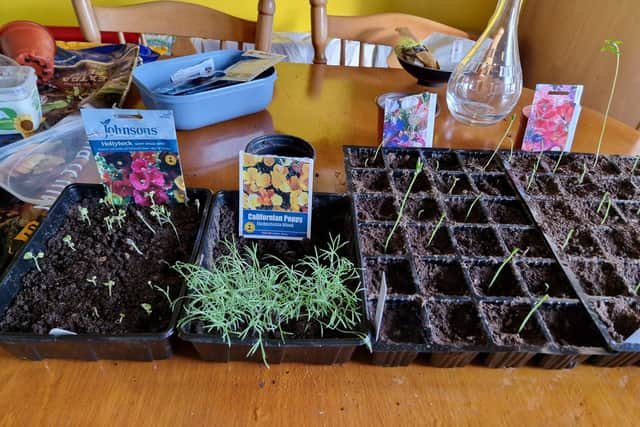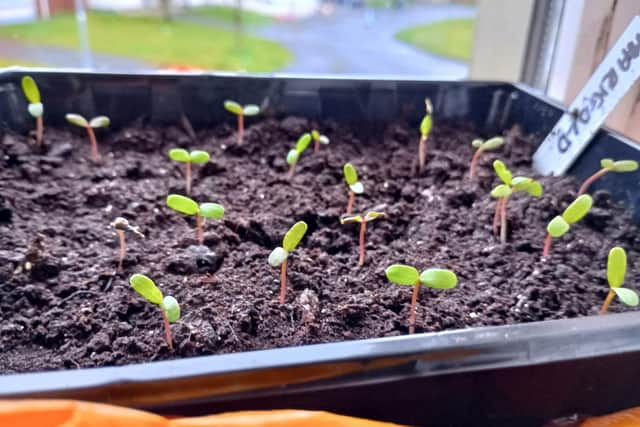Gone To Seed Gardening with Brendan: 5 tips to give your seedlings the best chance
and live on Freeview channel 276
Getting seeds to germinate can often be the toughest part of gardening and here’s five tips for other gardeners starting out based on what I have learned from green fingered experts and through trial and error to help make sure your new seedling charges have the best chance of surviving the next stage of their development.
Don’t try to do everything at once and don’t start too early
Advertisement
Hide AdAdvertisement
Hide AdThere’s a temptation at the tail end of winter to go a bit overboard with seed planting all at the same time, as I did back at the start of February. I’m glad I did get a head start with some seedlings but I have around 500 now, which is a lot of work if you are already working full-time or if you have a busy social schedule. With so many plants it is easy to forget about some of them and what’s hardening off where and what has been watered and when. Seedlings also need a lot of light to grow and unless you have a greenhouse of some sort it’s probably best to hold back on most things until the evenings lengthen a bit in March. It would also be better to sow seeds in succession every week or two weeks so you can move some plants on while you wait for others to germinate. They should be happy enough in their trays or seed pots for a good few weeks and won’t do well if moved on too early – wait at least until they have a few true leaves.


Under-watering
This is a technique I have seen more experienced gardeners recommending for sowing seeds and watering seedlings. Quite simply take a tray with no holes in it (I use an old baking tray) fill it with a bit of water and sit your seed tray or seedling pots inside it and let it soak up the water from the bottom up. This way you are not top watering and soaking the seedlings, as this can lead to them breaking or rotting, or displacing the seeds you have just sown. Bottom watering also encourages healthier root development as roots will seek out the water and if you water from the top they will stay close to the top of the pot or tray, which makes for a weaker plant. Be careful too not to water your young plants too frequently as this can lead to the roots becoming waterlogged and rotting off which will kill them, and /or fungus developing. Seed trays and pots will dry out quicker on top than below the surface so as a general rule, if you think a tray of seedlings or individual young plants needs a drink, lift it up first. If it feels very light then water, but it is heavy there is probably plenty of water in there already.
Keep a diary
This is something I am glad I did this time round. Use any old notepad or spare jotter to jot down dates of what you have sown and when. Be specific as you might have five different varieties of the same plant. Keeping a diary is very handy for taking some of the guess work out of gardening. It will help you determine when new seeds were planted or put in the fridge, when they are likely to germinate, how many weeks ago a particular batch of seeds sprouted and how old it is before you decide about potting on to bigger containers. Seeds all develop in different ways so some may look really big and healthy on top but their roots may not be well developed enough to transplant on. Also make sure to stick a label in your seed trays so you know what it is if you are planting different things. A lot of the first leaves to emerge look the same so it can be confusing if you don’t have any markers.


Right location, right pot
Make sure you do a bit of research on what you are growing. Most seedlings like a lot of direct sunlight but if it is too warm they can become sunburnt, but generally some direct sun and some shade is good for most seedlings. When moving seedlings on check if that type of flower, plant, vegetable or fruit has a tap root. If it doesn’t you might be best transplanting into just slightly larger containers at first as too much room can be a waste of compost and can also be bad for a small seedlings, while a seedling like a lupin, hollyhock or root vegetable with a tap root will be glad of the space in a bigger, taller pot or right into the ground when the danger of frost has passed.
The wobble effect
Advertisement
Hide AdAdvertisement
Hide AdMake your plants dance! Seedlings emerge with very tender stems, and that stem has to bear the weight of the whole plant through its development. So if have a fan you could put it on low during colder months while the seedlings are indoors to create a gentle breeze effect which will help strengthen the stems. If you’ve no fan sit the seedlings on the window sills and crack open the windows slightly in spring and let a bit of a breeze blow in over the seedlings on window sills as this will have the same effect. A stronger stem will help them cope with the elements when they are ready for hardening off and moving outside permanently.
Till next week!
Comment Guidelines
National World encourages reader discussion on our stories. User feedback, insights and back-and-forth exchanges add a rich layer of context to reporting. Please review our Community Guidelines before commenting.